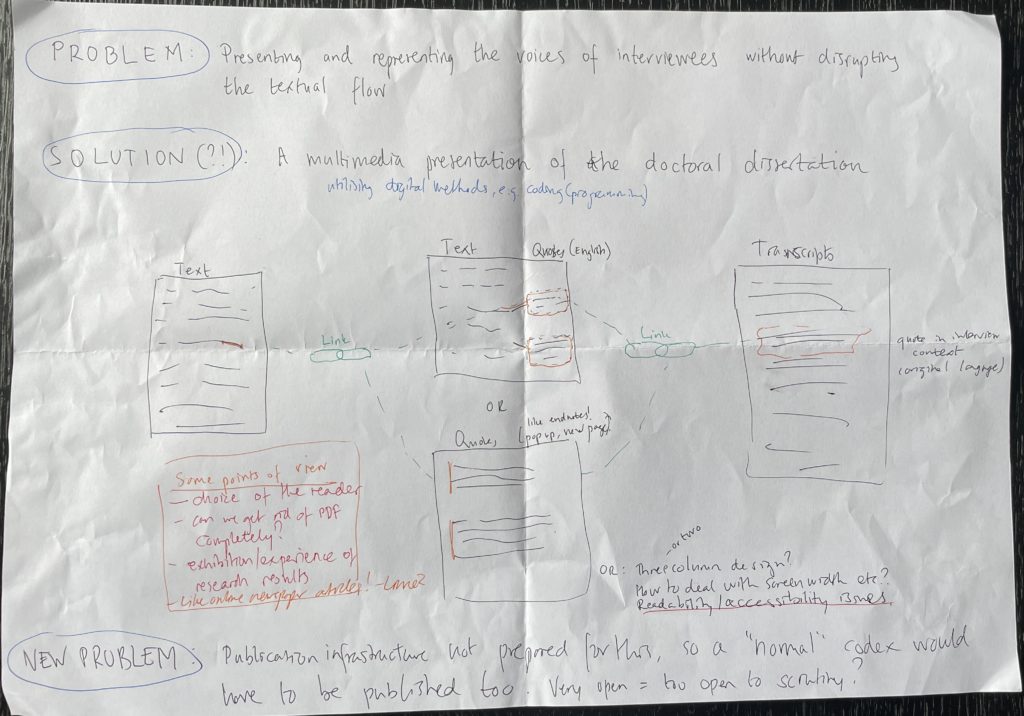I’m currently in Chester, taking a two week course in academic English. It came at an opportune time for me as I am in the process of writing of my doctoral research in a monograph.
This morning we did a writing exercise in free writing – a stream of consciousness from the academic mind, if you will. I had planned to ask our teacher about how to quote from interviews in academic writing (n.b. not how to write the quotes, but how to choose and integrate in the textual flow) so with this on my mind, my text flow was centered around this topic.
The problem: representing the interviewees without disrupting the textual flow
Quotes from interviews are useful to validate any claims you as a research might have when presenting results or findings. A quote can be more powerful than a paraphrase or summary of what was said since it represents the voice – an empirical voice – of the interviewee. The real life experience as told in an interview is part of what makes qualitative research compelling. It’s not just about the researcher’s analysis of the interviews but also about the researcher’s responsibility to retell and represent the stories told by interviewees.
From a textual perspective quotes take up a lot of space (useless in articles that are so limited in scope) and can also disturb the flow of the text, making it a smorgasbord of various thoughts and voices instead of being a presented dish at a Michelin restaurant.
How to overcome this hurdle? Is there a best practice – and is that practice really the best?
The solution (?!): a multimedia PhD thesis
The train of thought led me back to a topic I was keen on exploring in 2016 (but never did): the multimedia PhD thesis. If I was asked to explain what this is, I would say: it’s about moving on from the Gutenberg parenthesis and the pdf pseudo codex and instead utilising the marvel of technology to make the most of presenting the research to various audiences.
I could say more, but you get the general idea. I you want to, you can read more about multimedia theses in Coral Manton’s ”Multimedia and Non-Text PhD Research Outputs: Theses research project for the British Library EThOS web service”.
My idea for a solution to the interview quote problem is to use hyperlinks to display quotes supporting a statement made in the academic text. This way, a statement will be directly linked to the quotes supporting it, without having 3-4 repetetive blockquotes taking up space in the text body. The reader can choose whether they just want to read the article text or if they want to get closer to the sources by reading the quotes.

A quick sketch of hyperlink quotations (and some notes)
A possible extension is to link the quotations to the interview transcript, providing further context for the quote that could be interesting to study. This multilayered hyperlink approach make the transcription dataset more accessible than if it was published as bulk text data.
With this transparent presentation design, both the voice of the researcher and interviewee can be heard and the reader can compare the researcher’s analysis with the source material and make their own interpretation.
Mockup: does it work?
I thought I’d do a quick mockup to see if this is a feasible design idea. I’d also like to collect some views from readers on whether this would be an interesting way to read a paper or whether it’s just theoretically pleasing. The mockup will be based on my 2023 article of AI skills in libraries (CC BY-SA 4.0) and the associated dataset (an interview transcript) (CC BY 4.0). (The choice of licensing really pays off when you want to do experimentation like this! Open science ftw! \o/)
We’re soon heading out on a tour of the city so this section will be updated later…